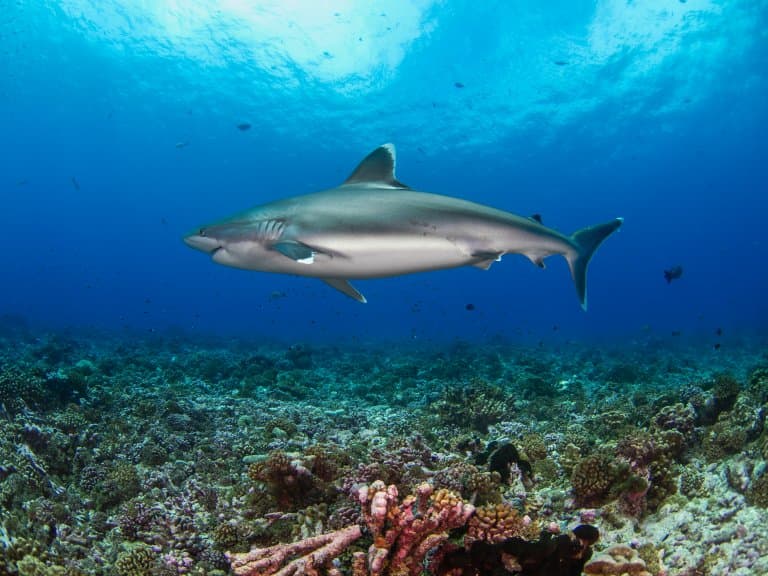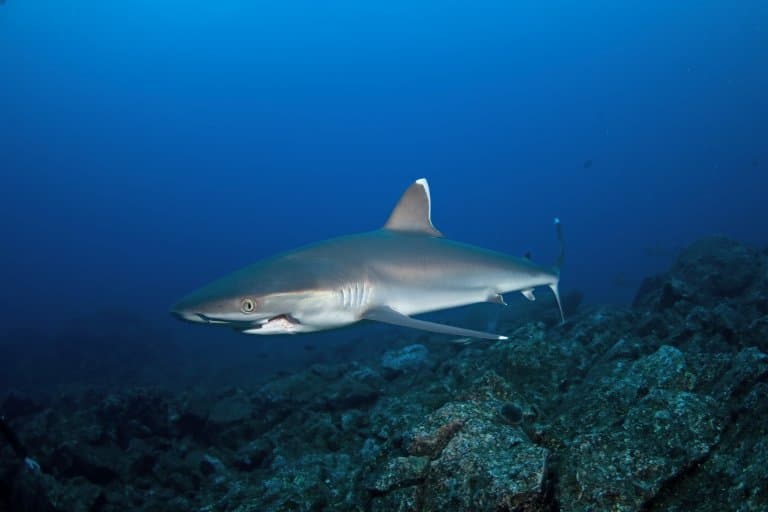Silvertip Shark Profile
Silvertip sharks are requiem sharks, so they’re sleek and powerful, and while they do have a touch of the characteristic ‘derpface’ that’s so common in the family, a lot of the gormless look has been exchanged with an expression of rigid determination.
And, as it happens, the look is backed up by an aggressive attitude and a dominant display of power over their peers in their local environment. They inhabits coral reefs and island coastal waters throughout the tropical Indian and Pacific Oceans.

Silvertip Shark Facts Overview
| Habitat: | Warm marine, coral reefs |
| Location: | Indian and Pacific Oceans |
| Lifespan: | Probably 18 years |
| Size: | (10 ft) |
| Weight: | 162.2 kg (357 lb) |
| Colour: | Silvery grey |
| Diet: | Fishes, rays, cephalopods |
| Predators: | Few, some larger sharks |
| Top Speed: | Unknown |
| No. of Species: | 1 |
| Conservation Status: | Vulnerable (IUCN) |
Silvertip sharks look a lot like whitetips, with a couple of key distinguishing features, and they occupy a similar niche. They’re agile and powerful sharks, with a mean steak that allows them to dominate others of their size and take on large prey.
They’re potentially dangerous when whipped into a feeding frenzy but have only been responsible for one recorded, un-provoked attack on humans.
Conversely, humans have killed many more of these sharks and the species is in decline as it’s caught in increasing numbers as a by-catch for the global fishing industry.
Interesting Silvertip Shark Facts
1. They’re not whitetips
Reef sharks can get a little tricky to tell apart, especially when more than one species is characterised by a light tip on the fins.
Both the whitetip and the silvertip are agile requiem sharks who patrol reef environments for food, and both have light patches on the dorsal and tail fins, but only the silvertip has these on the pectoral fins too.
Silvertips are also generally bigger and said to be more aggressive than whitetips, so if you’re getting mauled by one and can’t see its pecs through the cloud of blood, it’s more likely to be a silvertip. 1

2. They’re sleek
Another difference is the square-shaped head in whitetips, which in silvertips is replaced with a more rounded and slender snout.
The rest of them is pretty sleek, too, and these are consequently very agile sharks, capable of overpowering and outmanoeuvring food that’s almost as big as they are.
Common snacks include wahoo, which is a long, fast-swimming bony fish (named for their party attitude), and eagle rays (which are named after a Dr. Evil weapon), but they also take tuna, wrasses and other sharks.
They are fast enough to benefit from the feeding frenzies of other sharks and will dart in and out of a hunting patrol of other species to nab a quick bite.
3. They’re tough
But these sharks don’t have to be sneaky, they’re one, if not the most powerful predator in their range, and are more aggressive than most, so even similarly-sized sharks get pushed around by them.
Even other requiem sharks prefer to stay out of its way, so this species gets the first pick of the food when it wants to.
Silvertip sharks often patrol the waters covered in scars from members of their own species, so these are no-nonsense sharks.
4. They can be dangerous
As you’d expect from such a toothy attitude, this species has been involved in human injuries, but still rarely.
In general, they would rather stay away from divers, but at least one shark most definitely didn’t, and has been logged as responsible for the only unprovoked attack on record.
They get particularly excited when there’s food around, and their bold character makes them a potential danger to divers in this context too.
5. They have a stereotypical threat display
If feeling threatened in the water by divers, they will swim away around 15m, before turning and charging towards them!
However, before the shark reaches the perceived threat, they will brake and turn, gape its jaws and ‘shiver’. If the threat continues to upset, this might be followed by being bitten next time!
6. They have multipurpose teeth
The business end of a shark tells you a lot about what it eats. Wide, serrated teeth are for sawing into large-bodied prey to extract a chunk. Thin, long teeth are for forking slippery fishes.
This one has both. A knife on top and a fork underneath, which allows it to both grip and saw, and reflects the versatility of this species’ diet.
7. They sink at night
Tracking sharks is a bit difficult, especially when they’re as fast, bitey, and all over the place as these reef sharks.
White tips are tagged with what’s called pop-up archival tags, which are either glued or bolted onto the sharks and gradually fall off over time. While they’re attached, they collect data on the whereabouts of the shark and when they come loose, they pop up to the surface for collection.
Using this method, the nocturnal escapades of the sharks can be examined, and research has shown they like to leave the relative shallows of the reef at night and venture into deeper waters.
On the daily, Silvertips start their descent, usually not too far down, but every three days or so they’ll dive to between 200 and 800 meters.
Nobody’s sure why they do this, but since many smaller fish follow a similar pattern, it could be nocturnal foraging behaviour, but understanding their lives better would certainly help conservationists figure out how better to protect them. 2
8. Silvertip sharks are viviparous
This means the embryo is developed inside the body of the mother through a placental connection.
Courtship involves the male shark biting the female to hold her for copulation. Silvertip sharks will give birth to litters of usually 5-6 pups every other and the gestation period of 12 months.

9. They’re killed as by-catch
As with most species of large sharks, silvertips are threatened by the fishing industry. Longline, gillnet, trawl, and other methods of fishing all turn up this species as a waste product, and the number of sharks landed in this way is on the rise every year.
True statistics are hard to come by, as the numbers are usually downplayed or not reported at all, but tuna fisheries are thought to be a significant contributor.
The species is currently considered Vulnerable and in decline by the IUCN.
Silvertip Shark Fact-File Summary
Scientific Classification
| Kingdom: | Animalia |
| Phylum: | Chordata |
| Class: | Chondrichthyes |
| Order: | Carcharhiniformes |
| Family: | Carcharhinidae |
| Genus: | Carcharhinus |
| Species: | Carcharhinus Albimarginatus |
Fact Sources & References
- “Carcharhinus albimarginatus”, Florida Museum.
- Mario Espinoza (2015), “Movement patterns of silvertip sharks (Carcharhinus albimarginatus) on coral reefs”, Springer Link.
